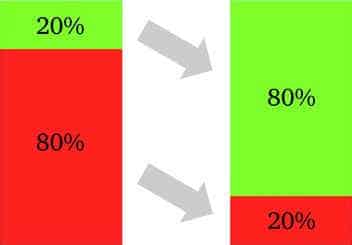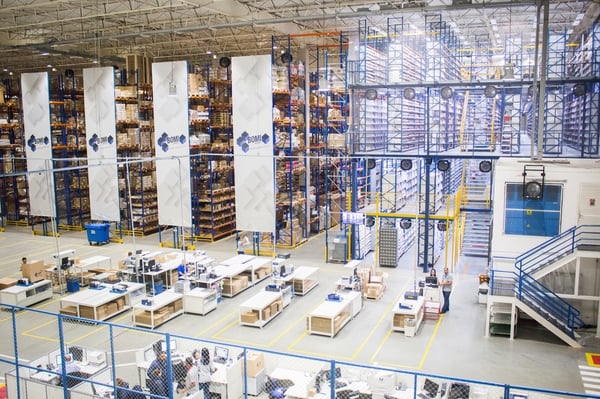How To Organize a Warehouse Efficiently
Published on October 10, 2019

Would you like to see the efficiency of your logistics improved? Organizing your warehouse layout efficiently can save you time, decrease stress, and help you be more cost-effective.
When planning your warehouse layout, you must have one simple objective in mind: streamline the time dedicated to picking operations.
Here are a few tips that will help you stock your products efficiently and optimize material handling operations and the flow of traffic in your warehouse.
BASIC ELEMENTS TO VERIFY
Security and cleanliness above all, needless to say. Besides that, make sure your warehouse meets the standards in the following domains:
- air and ventilation ducts,
- proper electrical system,
- climate control system,
- traffic lanes wide enough for easy movement.

ASSESSING YOUR WORKSPACE
Your primary concern is efficiency. If you can optimize your warehouse space, you have a competitive advantage. Your space must be 1) well divided and 2) allow for fluent circulation to load and unload.
Of course, the layout of your warehouse depends on the business you are in and on the volume and weight of your products. Here are some questions to help you optimize your space:
- Are my products stocked as units, case packs, or pallets?
- How much space do I need to stock all my products?
- What type of storage do I need – racks, cupboards, shelves, or other?
- Do I need many levels to store my products (mezzanines, storage platforms, etc.)?
- Are my storage compartments well adapted to the type of handling we do? If my products are stocked as units or case packs, do I have enough room to access the products? If I use mechanical equipment to move pallets, is the space designed for easy handling?
STORAGE PLATFORM
Platforms free up ground space and increase workable areas. Advantages:
|
|
RACKING
Racking allows to stock heavy and bulky products. Advantages:
For smaller products, add storage cabinets, bins, or pallets. |
|
WOODEN CRATES
Wood crates or boxes adapt to any needs since they are available in all sizes, contrary to a container for example. Advantages:
|
THE ABC ANALYSIS
Do you know the Pareto principle? Not to give you a lecture on this, but I urge you to read up on this. In fact, all entrepreneurs should be familiar with it so as to maximize the effectiveness of each of their business’ departments.
Simply put, the principle states that, for many events, roughly 80% of the effects come from 20% of the causes. Therefore, the best way to see concrete results is to work on the 20% of the causes.

https://www.leblogdudirigeant.com/efficacite-dirigeant-quest-loi-de-pareto/
This principle has been applied to various domains, one of which is inventory and shipment management. Joseph Juran, considered a pioneer in quality control management, used this principle to help businesses and observed that ‘experienced managers know that only a few major components are critical’. Juran developed the ABC analysis by dividing a business’ resources in three parts:
|
B: intermediate resources C: resources contributing to 5-10% of the revenue |
How can this principle help you organize your warehouse efficiently?
It helps you organize your storage space in 3 categories:
|
“A” products: These contribute the most to your business and must never be out-of-stock. They should be placed as close as possible to where you receive and ship out products.
“B” products: These have a certain contribution to your business, but require less inventory and can be placed second, after the “A” products.
“C” products: These products contribute the least to your business so they require minimal inventory. You can place these in the back of your warehouse.
|
If your products are stacked vertically and you use manual handling, you can use the same method to logically place your merchandise:
|
“A” products: stored at chest height
“B” products: stored below
“C” products: stored higher up
|
OTHER LAYOUT METHODS
There are other layout methods available based on stock rotation. Logically, you want to make sure the older stock is shipped out first, especially if it could degrade over time. Yet, many warehouses are so poorly organized that a lot of stock is lost or forgotten, emphasizing the need for clear management rules.
The removal strategy is chosen based on the types of products and the constraints they impose – products with expiry dates, perishable items, non-perishable items, to name a few.
Therefore, it may be that in a single business, there are various removal strategies according to the different types of products the business sells. Needless to say, planning is essential!
- FIFO (First In, First Out): used when you want to access the older stock first. The FIFO strategy implies that the products that were stocked first will move out first. This prevents items from degrading or being outdated.
- LIFO (Last In, First Out): used when you want to move out the latest stock first. The LIFO strategy implies that products that were brought in the last are moved out first oftentimes because they are more readily accessible. As long as the products don’t have an expiry date, this method should work fine, but of course would not work in the case of perishable items.
- FEFO (First Expired, First Out): used when you want to dispatch products according to their expiration date. Obviously, businesses selling perishable items with a ‘best before’ date will use this strategy to limit the waste.
- Of course, there are no hard and fast rules on the method to use, but it’s common sense to try to avoid any losses and to make the most out of your inventory.
All things considered, optimizing the efficiency of your warehouse requires much planning. You must think of safety, space management, what type of products you sell, their shelf life, as well as the best removal strategy for each product so as to avoid losses as much as possible.
If you leave nothing to chance, you will undoubtedly increase the productivity of your business. If you would like to invest in this domain, why not use the funds Buster Fetcher gets back for you to better organize your warehouse!





